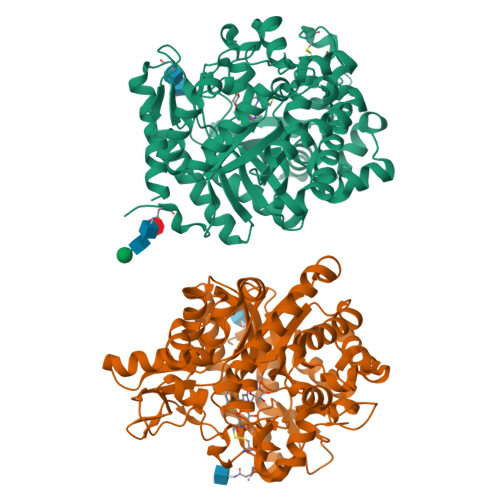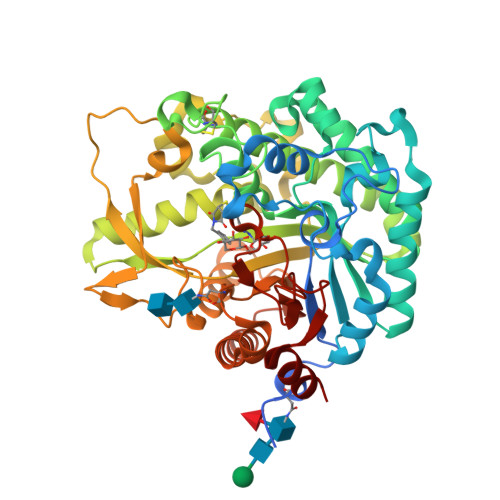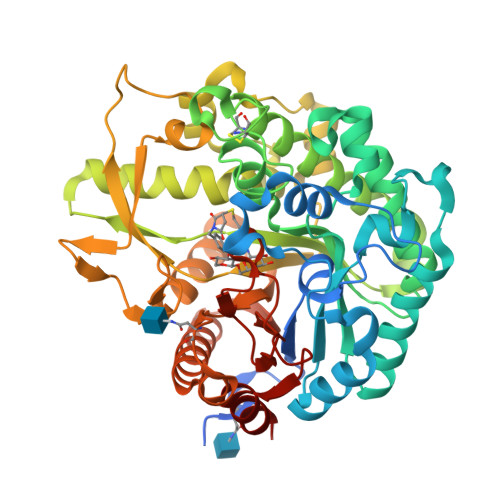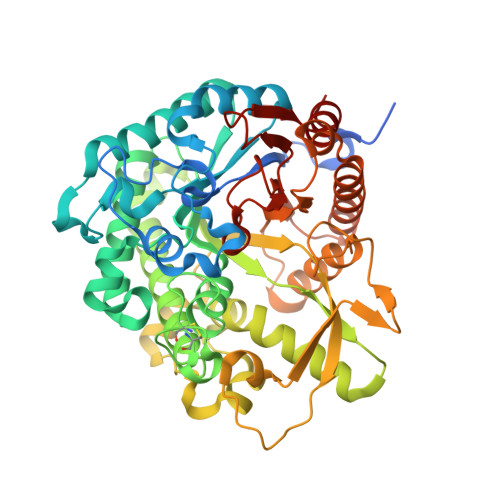Crystal structures of beta-primeverosidase in complex with disaccharide amidine inhibitors.
Saino, H., Shimizu, T., Hiratake, J., Nakatsu, T., Kato, H., Sakata, K., Mizutani, M.(2014) J Biological Chem 289: 16826-16834
- PubMed: 24753293
- DOI: https://doi.org/10.1074/jbc.M114.553271
- Primary Citation of Related Structures:
3WQ4, 3WQ5, 3WQ6 - PubMed Abstract:
β-Primeverosidase (PD) is a disaccharide-specific β-glycosidase in tea leaves. This enzyme is involved in aroma formation during the manufacturing process of oolong tea and black tea. PD hydrolyzes β-primeveroside (6-O-β-d-xylopyranosyl-β-d-glucopyranoside) at the β-glycosidic bond of primeverose to aglycone, and releases aromatic alcoholic volatiles of aglycones. PD only accepts primeverose as the glycone substrate, but broadly accepts various aglycones, including 2-phenylethanol, benzyl alcohol, linalool, and geraniol. We determined the crystal structure of PD complexes using highly specific disaccharide amidine inhibitors, N-β-primeverosylamidines, and revealed the architecture of the active site responsible for substrate specificity. We identified three subsites in the active site: subsite -2 specific for 6-O-β-d-xylopyranosyl, subsite -1 well conserved among β-glucosidases and specific for β-d-glucopyranosyl, and wide subsite +1 for hydrophobic aglycone. Glu-470, Ser-473, and Gln-477 act as the specific hydrogen bond donors for 6-O-β-d-xylopyranosyl in subsite -2. On the other hand, subsite +1 was a large hydrophobic cavity that accommodates various aromatic aglycones. Compared with aglycone-specific β-glucosidases of the glycoside hydrolase family 1, PD lacks the Trp crucial for aglycone recognition, and the resultant large cavity accepts aglycone and 6-O-β-d-xylopyranosyl together. PD recognizes the β-primeverosides in subsites -1 and -2 by hydrogen bonds, whereas the large subsite +1 loosely accommodates various aglycones. The glycone-specific activity of PD for broad aglycone substrates results in selective and multiple release of temporally stored alcoholic volatile aglycones of β-primeveroside.
Organizational Affiliation:
From the College of Science and Engineering, Aoyama Gakuin University, Sagamihara-shi, Kanagawa 252-5258, saino@chem.aoyama.ac.jp.























